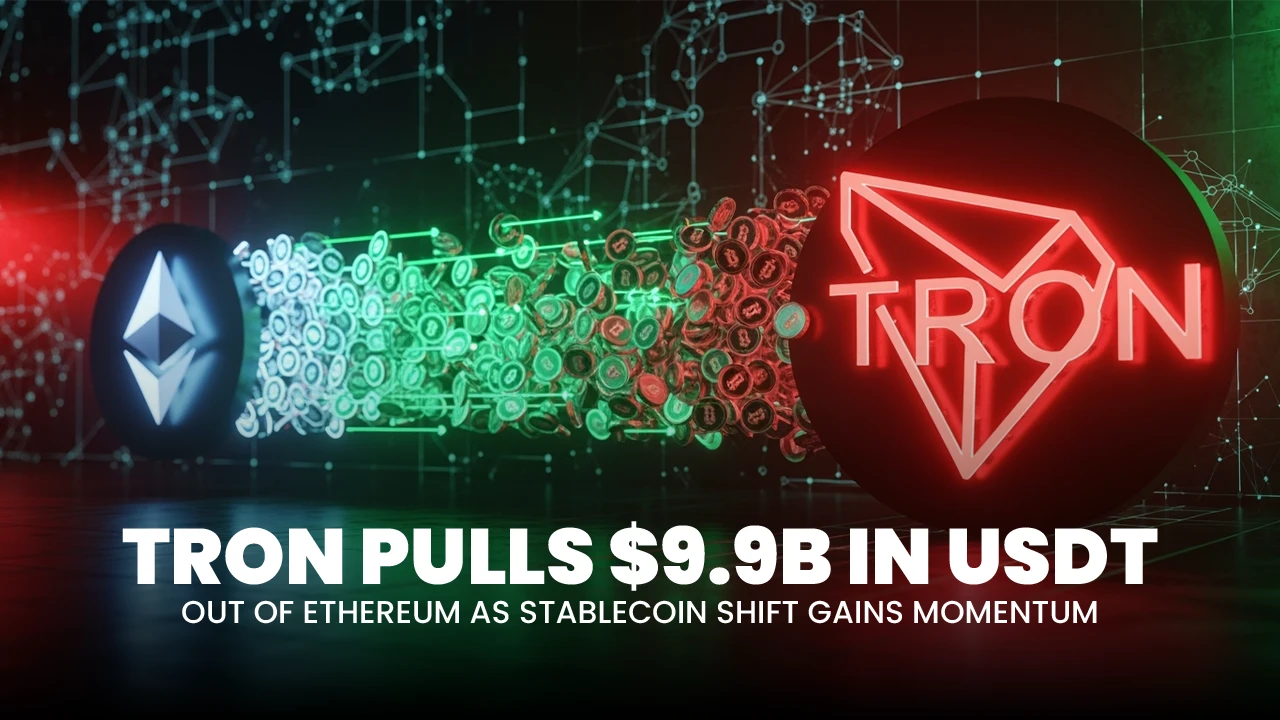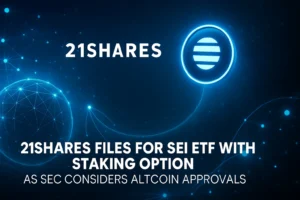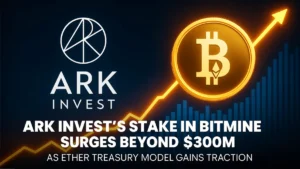TRON Pulls $9.9B in USDT Out of Ethereum as Stablecoin Shift Gains Momentum

TRON (TRX) has turned into a one-way liquidity sink in 2025 by pulling unprecedented volumes of USDT from Ethereum and keeping it locked within its network.
- USDT as the Main Driver and the Infrastructure That Holds It
- Surging User Activity Shows Broad Adoption
- TRON Surpasses Ethereum in USDT Supply
- Real-Time Social Media Evidence
- Why the Liquidity Stays on TRON
- Regional and Strategic Implications
- Conclusion
- Frequently Asked Questions (FAQs)
- Glossary of Key Terms
Data from CryptoQuant shows that $9.9 billion in USDT has moved from Ethereum to TRON this year. This is a 76 percent increase compared to $5.6 billion in 2024. Outbound traffic in the other direction is almost nonexistent. Only about $2,000 in USDT and around $700,000 in TRC-20 tokens have flowed back to Ethereum.
The numbers reveal a significant shift in blockchain stablecoin activity. TRON is no longer just a stopover point for capital. It is now a final destination where stablecoins arrive and remain. This marks TRON’s evolution into a primary settlement layer for global stablecoin transfers.
USDT as the Main Driver and the Infrastructure That Holds It
USDT is the main engine behind this shift. TRON offers lower transaction fees, faster confirmation times, and a growing base of merchants and DeFi platforms.
ALSO READ: Grayscale Fuels SUI and Cardano Boom as Binance Launches Offensive on Crypto Crime
These qualities have made the network the preferred location for high-volume stablecoin transfers. On August 9, Ethereum to TRON USDT transfers reached $7.7 million. In June, ERC-20 stablecoin bridging hit a peak of $19 million in a single day.
Specialized cross-chain facilitators such as “Bridgers” have moved $8.4 billion worth of assets in 2025 alone. TRON’s ability to handle this volume is made possible by its Delegated Proof of Stake (DPoS) consensus system.
DPoS allows rapid and low-cost transactions while keeping throughput high enough to serve as a dependable settlement environment for stablecoins.
Surging User Activity Shows Broad Adoption
The liquidity surge is mirrored by massive increases in user participation.
- Daily bridging transactions reached 7,500 on July 17, almost 19 times higher than the previous year.
- Active addresses using bridges rose to 5,000 per day in mid-July, which is a 31 times increase year over year.
- TRON’s average daily transaction count has grown from 4.3 million in early 2024 to 8.4 million in May 2025, a rise of 95 percent.
These figures indicate that adoption is not confined to large institutions or whales. Individual traders, payment processors, and retail users are all contributing to the growth.
TRON’s DPoS-based infrastructure plays a crucial role in delivering the fast, inexpensive transactions that make this level of adoption possible.
TRON Surpasses Ethereum in USDT Supply
TRON’s position is not only about inbound flow. It now leads the market in total USDT supply. In July 2025, TRON was holding $80.8 billion in USDT compared to Ethereum’s $73.8 billion.
ALSO READ: XDC and TRON Smash Milestones as Bullish Rides ARK Invest, BlockRock to Prep a $4.8B IPO
This reversal comes after a wave of Tether minting activity. In 2025 alone, Tether created an additional $16 billion USDT on TRON, bringing its total issuance on the network to more than $75.7 billion.
From January to July 2025, TRON’s USDT supply increased by roughly $20 billion. July alone saw between $6 and $8 billion minted, which was the largest monthly amount in Tether’s history.
Over half of all USDT in circulation now resides on TRON. On July 28, Tether added another $1 billion to TRON’s supply, bringing the total minted this year to over $23 billion.
This dominance reflects a deeper integration between TRON’s settlement infrastructure and Tether’s operational needs.
Real-Time Social Media Evidence
The liquidity trend is also visible in real-time data posted on social media. Whale Alert, a leading on-chain transaction tracker, shared the following in June 2025:
https://publish.twitter.com/?url=https://twitter.com/Ashcryptoreal/status/1945481296169390261#
Blockchain analytics firm Lookonchain also highlighted that Tether minted another $1 billion USDT on TRON on June 9, following a $2 billion issuance in May. According to Lookonchain, Tether has minted a total of 16 billion USDT on TRON in 2025.
These posts give direct and verifiable proof of the scale and frequency of the minting events that are fueling TRON’s stablecoin accumulation.
Why the Liquidity Stays on TRON
The near one-way nature of liquidity flow into TRON is a result of its technical and economic advantages.
- Speed: Transactions reach finality within seconds, which is essential for fast-moving markets.
- Low Fees: Even during high network activity, average fees remain around $1.18.
- Scalability: The DPoS system enables the network to process millions of transactions per day without congestion.
Once assets are bridged to TRON, users often find little reason to move them back to Ethereum. The local ecosystem offers DeFi platforms, payment integrations, and trading opportunities that meet most needs without leaving the network.
Regional and Strategic Implications
TRON’s rapid growth has particular resonance in emerging markets where banking infrastructure can be limited. For merchants, traders, and remittance senders, the combination of low fees and high-speed transactions is an attractive alternative to traditional systems.
Ethereum faces the challenge of countering these trends. It may need to improve scaling solutions, adjust gas fee structures, or enhance cross-chain user experience to compete. For now, TRX is solidifying its lead in stablecoin settlement volume.
Institutions could also be drawn to TRON’s growing liquidity pool. Large-scale settlements, treasury operations, and cross-border payments could all benefit from a network that offers both stability and efficiency.
| Metric | 2024 Value | 2025 Value | Change |
| USDT bridged from Ethereum | $5.6B | $9.9B | +76% |
| Outbound flows to Ethereum | Negligible | ~$2K USDT / ~$700K tokens | Practically zero |
| Daily bridging transactions | ~395/day | 7,500 (peak) | ~19× increase |
| Active addresses (daily) | ~161/day | 5,000 | ~31× increase |
| 30 day average daily transactions | 4.3M | 8.4M | +95% |
| USDT supply on TRX | <$60B | ~$80.8B | Surpassed Ethereum |
| USDT minted in 2025 on TRX | — | +$16B–$23B total | Large issuance surge |
| July 2025 issuance | — | $6–8B | Largest monthly record |
Conclusion
TRON’s emergence as a one-way liquidity magnet marks a significant turning point in the stablecoin economy. The network’s ability to attract and retain USDT at this scale is powered by the efficiency of Delegated Proof of Stake.
With $9.9 billion bridged from Ethereum, minimal outbound movement, and surging user numbers, TRON has established itself as a critical settlement layer.
The minting surge and supply dominance show that Tether’s operations increasingly depend on TRON’s infrastructure. As more users and possibly institutions adopt TRX for fast and inexpensive stablecoin transfers, the network’s influence over digital dollar liquidity is set to grow even further.
Frequently Asked Questions (FAQs)
- What does “one-way liquidity magnet” mean in this context?
It means that stablecoins are flowing into TRX from Ethereum in large volumes while very little flows back. - How much USDT has been bridged to TRON in 2025?
Around $9.9 billion, which is 76 percent higher than in 2024. - Why do stablecoins tend to remain on TRX?
Because the network offers lower fees, faster transactions, and plenty of in network services. - Has TRX passed Ethereum in total USDT supply?
Yes, TRX holds roughly $80.8 billion compared to Ethereum’s $73.8 billion. - What role does DPoS play in TRX’s growth?
DPoS allows TRX to process transactions quickly and cheaply, supporting its growth as a stablecoin hub.
Glossary of Key Terms
- USDT: Tether’s stablecoin pegged to the U.S. dollar.
- Bridging: Moving digital assets between different blockchains.
- Liquidity Sink: A place where assets flow in and remain without returning.
- Delegated Proof of Stake (DPoS): A consensus system where token holders vote for validators to secure the network.
- TRC-20: The TRX token standard for fungible tokens.
- Settlement Layer: A blockchain primarily used for finalizing transactions and holding liquidity.




